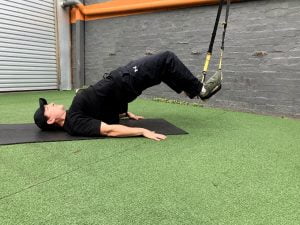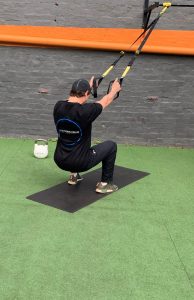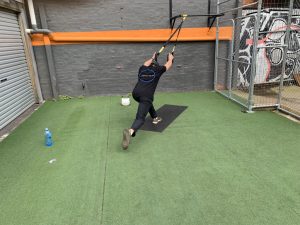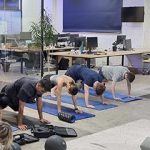Suspension Training
Is it the best resistance training method for strength, mass and muscular performance in older adults?
Once you reach 20 years of age, your muscle strength will reduce by 1.5% and muscle size by 1-2% per year on average. To put that into perspective, take an average 20yo, 75kg male with a healthy 40% of that being lean muscle mass; that’s 30 kg of lean mass. By the time he reaches 30yo this mass will reduce by 3-4kg and by 40yo that becomes 6-8kg losses. Therefore, unless our subject is doing regular resistance training to counter this trend, by the time he is 30yo his resting metabolic rate (BMR) requires 3-400kcal less per day compared to when he was 20. In other words, the energy required to run his body at rest significantly reduces over time if there is no action taken in order to slow if not halt this process for long periods of time. Having that level of metabolic function loss has major compounding effects in terms of how much body fat you will store not to mention subsequent weakness, neuromuscular dysfunction, possible injury and mortality risks.
How can Resistance Training Help Slow This Process?
Current guidelines widely recommend resistance training to mitigate age-related impairments in muscle strength, mass, power and functional performance. In order to optimize muscle strength and mass gains in older adults, Resistance training (RT) should be performed at least twice weekly, with 8-10 exercises for major muscle groups at moderate to high intensities and slow velocity. In addition, if a light load is required, repetitions should be performed near to concentric failure in order to optimize the adaptation. Considering that age-related impairments are greater in muscle power than in muscle strength and mass, incorporating power specific training could be a useful additional RT mode compared to standard progressive RT for functional performance.
What is Suspension Training (ST)?
Several resistance training (RT) methods are suitable for enhancing muscle strength, mass, power and functional performance in older adults. However, less known RT modes also appear capable of optimizing these essential adaptations for older adults. Suspension training is as it sounds, body parts attached to suspended hanging straps such as the TRX suspension trainer, creating an unstable environment and using the body weight against gravity to perform multi-joint exercises. ST provides a progressive stimulus in the target muscles and a substantial activation in core muscles, suggesting it could be a promising RT strategy to improve muscle strength, mass, power and functional performance.
Core stability training from ST
Strategies aiming to stimulate the core muscles through the simulation of an unstable training environment have been proven to have a dramatic positive effect on health (e.g. Balance Board, BOSU and Swiss Ball). In ST, instability is simulated by suspending the body’s segments thought hanging straps, which creates an unstable environment where exercises are performed using body weight and gravity as load. The ST has a simple configuration, takes up little space, can be adjusted to suit physical requirements and permits a great variety of exercises. this method allows the adjustment and progression of the instability and training overload, even for the very elderly. Several studies investigating the immediate effects of ST support the notion that it may produce substantial improvements on functional performance due to higher activation of the core muscles compared with RT modes performed on stable environment.
Conclusion
ST is clearly a great method for improving most metrics of strength amongst aging adults. But, as for whether it is the best or even the safest, more study is still required. Furthermore, if you are suffering with dysfunction currently it is vitally important you seek medical advice before beginning any resistance training modality, RT can cause great stress upon you body and damage can occur if completed incorrectly. Below I have outlined a few of the more basic yet highly beneficial exercises you could try to get started. Take it slow and follow the guidelines, within a few weeks it is very likely you will notice some tangible results that will have a positive effect on your day to day.
Suspension training circuit for beginners
Principles
- Aim to achieve near concentric failure from each set
- Maintain optimum for or discontinue the movement
- Repeat 3-4 times before progressing to the next exercise
- Repeat 3-4 times per week for strength gains to be established
Pectoralis stretch
With your arms out wide in the chest stretch, standing up straight, reach one foot far behind you (like a lunge). Ground yourself through the heel of the front foot and move your body forward. The stretch will be felt in the front of the thigh behind you. Keep the spine tall and the chest big.
Lat stretch
Facing the ST anchor point, with your arms straight, reach your hips back keeping the spine straight. Relax and head and neck, allowing the head to drop between the shoulders. Keep your weight in your heels and take a few deep breaths. You will feel this all down the back and underneath the armpits.
Planks
Keeping the torso rigid, press the feet into the foot cradles and lift into a plank position. Keep the feet flexed and the glutes, legs, torso and shoulders fully engaged. Continue if a perfect plank can be maintained
crunches
Place the straps so that the handles hang about a foot off the ground. Place your feet in the stirrups so that the tops of your feet are facing towards the ground. Place your hands on the ground and get into push-up position. Pull your knees into your chest and then straight back out.
Chest press
Set the strap to mid-length and get into push-up position with a handle in each hand. Slowly lower your body, focusing on stabilizing yourself. Keep your core tight and push yourself back up.
Glute/Hamstring bridge
insert one foot at a time into hanging cradles. Bend at the knees. Maintaining balance with your hands on the floor, drive your hips up, forming a straight line with your body. Pause and feel the contraction in your glutes then slowly lower yourself to the starting position.
Squat
Start by grabbing the handles of the ST, facing towards it. Drop down into the squat position, making sure that your arms and back are straight, your knees form a 90-degree bend, and the pressure of your body weight is in your heels rather than your toes.
Single leg deadlift
Holding the straps facing the point of suspension with back straight, chest out, and shoulders pulled down and back. Keep the raised leg and torso in alignment, inhale driving the hips back slightly as you let the torso fall forward and the raised leg sweep back behind you.
Author
Damian Boddy
Head Personal Trainer Sydney
Disclaimer: The training and instructional content contained on this website should be taken as information and not medical advice. Please consult your health professional before attempting these exercises.














